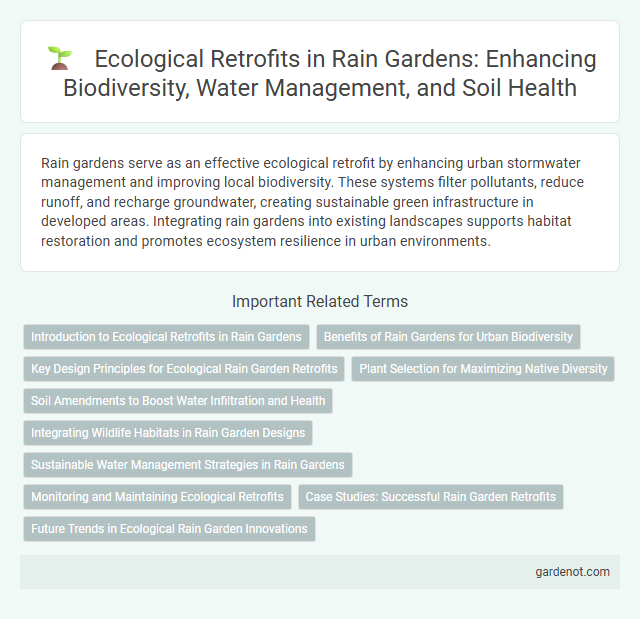Rain gardens serve as an effective ecological retrofit by enhancing urban stormwater management and improving local biodiversity. These systems filter pollutants, reduce runoff, and recharge groundwater, creating sustainable green infrastructure in developed areas. Integrating rain gardens into existing landscapes supports habitat restoration and promotes ecosystem resilience in urban environments.
Introduction to Ecological Retrofits in Rain Gardens
Ecological retrofits in rain gardens enhance urban stormwater management by integrating native vegetation and soil amendments that improve water infiltration and pollutant filtration. These retrofits restore natural hydrological functions, increase biodiversity, and reduce surface runoff, mitigating urban flooding and water pollution. Implementing ecological retrofits facilitates resilient green infrastructure that supports sustainable watershed management and urban ecosystem health.
Benefits of Rain Gardens for Urban Biodiversity
Rain gardens serve as ecological retrofits that enhance urban biodiversity by creating habitat for pollinators, birds, and beneficial insects. They improve soil health and water infiltration, reducing stormwater runoff and mitigating urban flooding. By supporting native plants and increasing green space connectivity, rain gardens foster resilient urban ecosystems.
Key Design Principles for Ecological Rain Garden Retrofits
Ecological rain garden retrofits prioritize enhancing native biodiversity, improving stormwater infiltration, and supporting habitat connectivity through thoughtful plant selection and soil amendment. Key design principles include optimizing site topography to capture runoff efficiently, using permeable media with appropriate texture for maximum water retention, and incorporating layered vegetation to promote pollutant filtration and erosion control. Emphasizing functional diversity and resilience ensures the rain garden adapts to varying precipitation patterns while contributing to urban ecological infrastructure.
Plant Selection for Maximizing Native Diversity
Selecting native plant species for rain gardens enhances ecological retrofit efforts by supporting local biodiversity and improving stormwater management. Incorporating diverse native grasses, perennials, and shrubs creates habitats for pollinators and wildlife while increasing soil stability and water infiltration. Prioritizing region-specific plants like Echinacea purpurea, Carex pensylvanica, and Asclepias tuberosa maximizes ecological benefits and resilience in urban landscapes.
Soil Amendments to Boost Water Infiltration and Health
Soil amendments in ecological retrofit of rain gardens enhance water infiltration by improving soil structure and porosity, promoting efficient stormwater absorption. Incorporating organic matter such as compost increases microbial activity and nutrient availability, supporting plant health and resilience. Amendments like biochar reduce soil compaction and retain moisture, optimizing the rain garden's capacity to manage runoff and sustain ecosystem functions.
Integrating Wildlife Habitats in Rain Garden Designs
Rain garden designs incorporating ecological retrofits enhance urban biodiversity by creating microhabitats for native species such as pollinators, amphibians, and birds. Strategic placement of native plants and water features supports wildlife corridors and fosters resilient ecosystems within urban environments. Integrating diverse vegetation layers and structural complexity improves habitat connectivity, promoting long-term ecological sustainability.
Sustainable Water Management Strategies in Rain Gardens
Ecological retrofits in rain gardens enhance sustainable water management strategies by integrating native vegetation and permeable substrates to improve stormwater infiltration and reduce runoff. These systems harness natural processes to filter pollutants, recharge groundwater, and support biodiversity within urban landscapes. Optimizing soil composition and plant selection maximizes resilience to varying precipitation patterns and climate change impacts.
Monitoring and Maintaining Ecological Retrofits
Monitoring and maintaining ecological retrofits like rain gardens ensures optimal performance by tracking soil moisture, plant health, and runoff capture efficiency. Regular inspections and adaptive management address sediment buildup, invasive species, and plant vitality, supporting long-term stormwater management goals. Data from sensors and periodic assessments help refine maintenance schedules to enhance pollutant removal and biodiversity benefits.
Case Studies: Successful Rain Garden Retrofits
Successful rain garden retrofits demonstrate significant improvements in stormwater management and urban biodiversity, as seen in Portland's Tryon Creek Watershed retrofit, which reduced runoff by 40%. Philadelphia's Green City, Clean Waters program highlights effective retrofitting techniques that integrate rain gardens with existing infrastructure to mitigate combined sewer overflows. These case studies exemplify how ecological retrofits enhance water quality, support native vegetation, and promote sustainable urban landscapes.
Future Trends in Ecological Rain Garden Innovations
Future trends in ecological rain garden innovations emphasize integrating smart water management technologies and native plant biodiversity to enhance stormwater filtration and habitat creation. Advanced materials such as permeable substrates and biochar are being developed to improve soil health and pollutant absorption. Urban planners are increasingly prioritizing multifunctional rain gardens that combine flood mitigation with carbon sequestration and aesthetic urban green spaces.
Ecological retrofit Infographic

 gardenot.com
gardenot.com